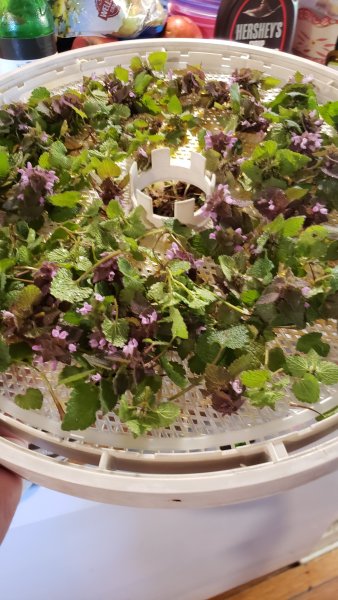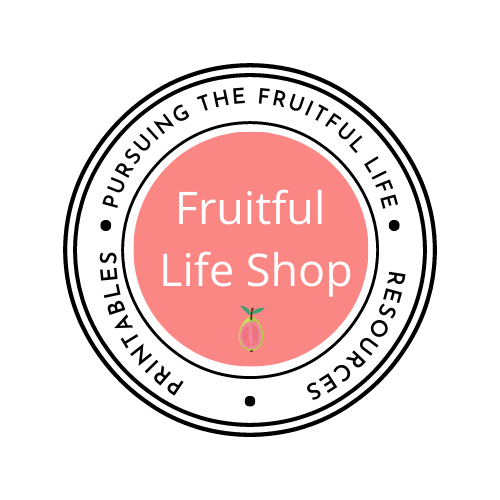Dehydrating purple dead nettle is one of the first things I now do as Spring launches forth. This plant is viewed as an unwanted weed by many, but the truth is that it offers a lot of beneficial qualities from nutritional to medicinal. Today, I’d like to share why dehydrating purple dead nettle is a smart choice for those who are interested in building their natural herbal pantry and a few ways you can use this wonderful herb. (This post contains affiliate links.)

The “nicer” cousin to Stinging Nettle
Purple dead nettle is in the mint family and is kindly known as the nicer cousin to stinging nettle. A stinging nettle has larger serrated leaves and tiny “hairs” up and down its stalk that aggravates the skin if touched, thus, the “sting”. Thankfully, purple dead nettle does not have this effect!
Though the two plants have some similarities, they don’t look a lot alike, and dead nettle is very easy to identify, plus it probably grows right in your own backyard!
Purple Dead Nettle Nutritional Benefits
Vitamin C, vitamin A, vitamin K, iron, and fiber are just some of the nutritional benefits of purple dead nettle. When used in culinary recipes, it does well as a garnish, complements other greens (think salads or sauteed), as a pesto, and in soups and other recipes that use greens, like smoothies.
Dead nettle tastes earthy and rich, like spinach and kale.
Purple Nettle Medicinal Benefits
To me, this is where this plant shines. Purple dead nettle packs a medicinal punch that demands a place in our home apothecary. The leaves and tops are used for a host of herbal medicine applications and their main properties are:
- Mild antihistamine
- anti-inflammatory
- antimicrobial
- astringent
- immunostimulating
- nutritive
- styptic
This makes purple dead nettle a great choice for first aid salves, as a poultice, and as an immune-boosting, anti-inflammatory tea or capsule.
Purple dead nettle has a high dose of vitamin C and bioflavonoids, which makes it a great treatment for winter colds or seasonal allergies.
Some caution when using Purple Dead Nettle
It is important to fully understand the properties of any herb before using them as a treatment for any condition. For example, purple dead nettle has diuretic and laxative properties, so always use the recommended doses and application methods when crafting remedies at home.
Because of these properties, dead nettle makes a great herb to include in detox and cleansing protocols for the body. Always start with the smaller doses to gauge how your body responds to the herb.
How to harvest Dead Nettle
Purple nettle is probably growing in your own yard and is generally safe to harvest as long as no chemicals have been used to treat the area and no risk of animal or livestock contamination is present. For example, I do not harvest dead nettle from our fenced-in backyard because our chickens and dog frequent those spaces.
You want to avoid the sides of roads where chemicals may be frequently sprayed as well.
To harvest, simply snip off the flowering tops and leaves from the dead nettle stalks, or, harvest the whole stalks and bring them inside to clean.

Here, you can see that I harvested the whole stalks. I did this because I was clearing an area around some other plants and my husband was getting ready to mow that area.

Once I got them inside, I rinsed them under cool water to ensure that the leaves would be free from pests, dirt, and debris. Then, I picked off the tops and good-looking leaves for my dehydrator trays. If I am using them fresh in a recipe, I lay them on a towel to dry until I’m ready to use them. (This is the dehydrator I use and it is great!) (affiliate link- I am an Amazon Associate and receive a commission for products purchased through my links at no additional cost to you.)

The above photo shows what I do not use in dehydrating. You can see that the flowers and tops and leaves are on the dehydrator tray behind my hand, but the stalk and a sickly leaf are what I discard.

Once the dehydrated trays are full, I dehydrated them for about 24 hours at the lowest setting. Always check to make sure that they are fully dry, especially the heads, before transferring them to storage. The tops and leaves should be crisp and crumble easily between your fingers.
How do you store Dead Nettle?
I use mason jars to store mine. Label and date the jars so you don’t forget what they are and when you harvested them.
Store your purple dead nettle in a cool, dry location out of sunlight until you are ready to use. The dried herbs should keep for up to two years in mason jars, longer if you seal them in mylar bags instead of jars. Typically, dried herbs and spices begin to lose their potency after three years, which is why it is important to label and date everything.
I hope this inspires you to utilize this superfood from nature in ways that will benefit your family! For more herbal goodness, please visit my other posts on Fruitful Vine Woman!












Do they lose some of their potency when dried?
Can you freeze them?
It’s my understanding that dehydrating at a low temperature will not affect potency. I have no experience with freezing except for culinary purposes. Hope this helps!